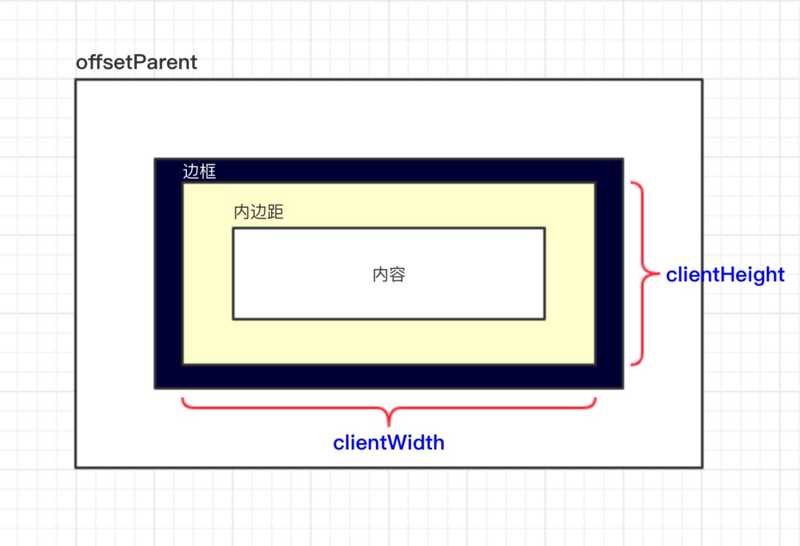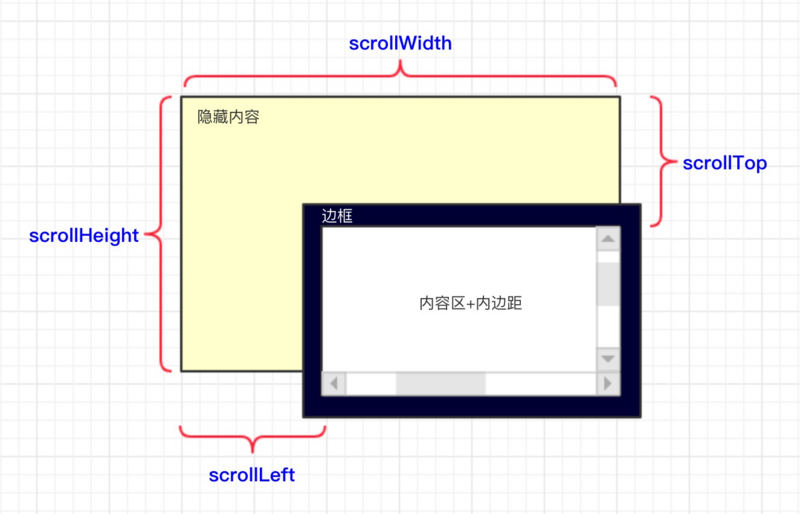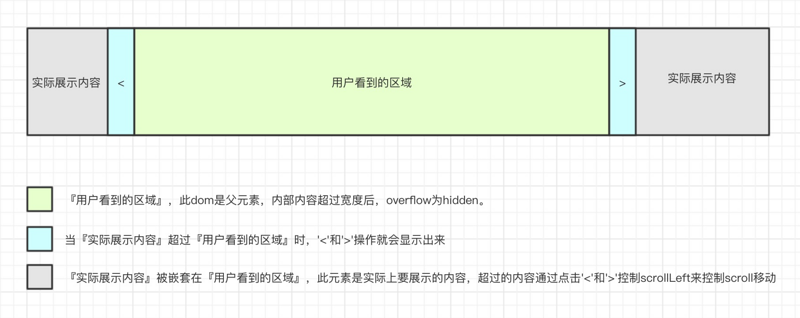жӮЁеҘҪпјҢзҷ»еҪ•еҗҺжүҚиғҪдёӢи®ўеҚ•е“ҰпјҒ
иҝҷзҜҮж–Үз« з»ҷеӨ§е®¶еҲҶдә«зҡ„жҳҜжңүе…іе°ҸзЁӢеәҸдёӯеҰӮдҪ•и®ҫи®Ўclick-scroll组件зҡ„еҶ…е®№гҖӮе°Ҹзј–и§үеҫ—жҢәе®һз”Ёзҡ„пјҢеӣ жӯӨеҲҶдә«з»ҷеӨ§е®¶еҒҡдёӘеҸӮиҖғпјҢдёҖиө·и·ҹйҡҸе°Ҹзј–иҝҮжқҘзңӢзңӢеҗ§гҖӮ
дёҖ. иғҢжҷҜ
жңүдәӣдёҡеҠЎйңҖжұӮпјҢиҰҒжұӮеүҚз«Ҝеұ•зӨәзҡ„еҶ…е®№еӨҡж—¶еҸҜд»ҘйҖҡиҝҮscrollзҡ„еҪўејҸжӢ–жӢүжҹҘзңӢпјҢдҪҶжҳҜеӨӘеӨҡзҡ„ж»ҡеҠЁжқЎеҸҲйҖ жҲҗйЎөйқўеӨӘд№ұпјҢдәҺжҳҜе°ҒиЈ…дәҶиҝҷдёӘclick-scroll 组件гҖӮеңЁз»„件дёҠи®ҫе®ҡеҘҪеұ•зӨәзҡ„дҪҚзҪ®е’Ңз©әй—ҙеӨ§е°ҸпјҢеңЁз»„件еҶ…йғЁж”ҫзҪ®е®һйҷ…иҰҒеұ•зӨәзҡ„еҶ…е®№пјҢе®һйҷ…еұ•зӨәзҡ„еҶ…е®№е®ҪеәҰжҲ–й•ҝжҲ–зҹӯйғҪз”ұжӯӨ组件жқҘжҺ§еҲ¶гҖӮ
дәҢ. еҠҹиғҪ
组件еҶ…зҡ„еҶ…е®№е®ҪеәҰи¶…иҝҮ组件е®ҪеәҰж—¶пјҢ组件дёӨдҫ§дјҡиҮӘеҠЁеҮәзҺ°гҖҺе·ҰеҸіз§»еҠЁгҖҸдәӨдә’гҖӮ
еҪ“еҶ…йғЁеұ•зӨәзҡ„еҶ…е®№и¶…иҝҮ组件зҡ„еҸҜи§ҒеҢәеҹҹж—¶пјҢеҸҜд»ҘеңЁз»„件зҡ„еҸҜи§ҒеҢәеҹҹеҚ•еҮ»жӢ–еҠЁжҹҘзңӢеҶ…е®№
дёү. иғҢжҷҜзҹҘиҜҶпјҢе…ғзҙ еӨ§е°Ҹзҡ„жөӢйҮҸ
1.еҒҸ移йҮҸпјҲoffset dimensionпјү:
е…ғзҙ еңЁеұҸ幕дёҠеҚ з”Ёзҡ„еҸҜи§Ғзҡ„жүҖжңүз©әй—ҙпјҢе…ғзҙ зҡ„еҸҜи§ҒеӨ§е°Ҹз”ұе…¶й«ҳеәҰгҖҒе®ҪеәҰеҶіе®ҡпјҢеҢ…жӢ¬жүҖжңүеҶ…иҫ№и·қгҖҒж»ҡеҠЁжқЎе’Ңиҫ№жЎҶеӨ§е°ҸгҖӮз”ұеӣӣдёӘеҖјеҶіе®ҡпјҡoffsetHeightгҖҒoffsetWidthгҖҒoffsetLeftе’ҢoffsetRightгҖӮ
offsetHeightпјҡе…ғзҙ еңЁеһӮзӣҙж–№еҗ‘дёҠеҚ з”Ёзҡ„з©әй—ҙеӨ§е°ҸпјҢд»ҘеғҸзҙ и®ЎгҖӮеҢ…жӢ¬е…ғзҙ зҡ„й«ҳеәҰгҖҒпјҲеҸҜи§Ғпјүж°ҙе№іж»ҡеҠЁжқЎзҡ„й«ҳеәҰгҖҒдёҠиҫ№жЎҶй«ҳеәҰе’ҢдёӢиҫ№жЎҶй«ҳеәҰгҖӮ
offsetWidthпјҡе…ғзҙ еңЁж°ҙе№іж–№еҗ‘дёҠеҚ з”Ёзҡ„з©әй—ҙеӨ§е°ҸпјҢд»ҘеғҸзҙ и®ЎгҖӮеҢ…жӢ¬е…ғзҙ зҡ„е®ҪеәҰгҖҒпјҲеҸҜи§ҒпјүеһӮзӣҙж»ҡеҠЁжқЎзҡ„е®ҪеәҰгҖҒе·Ұиҫ№жЎҶе®ҪеәҰе’ҢеҸіиҫ№жЎҶе®ҪеәҰгҖӮ
offsetLeftпјҡе…ғзҙ зҡ„е·ҰеӨ–иҫ№жЎҶиҮіеҢ…еҗ«е…ғзҙ зҡ„е·ҰеҶ…иҫ№жЎҶд№Ӣй—ҙзҡ„еғҸзҙ и·қзҰ»гҖӮ d.
offsetTopпјҡе…ғзҙ зҡ„дёҠеӨ–иҫ№жЎҶиҮіеҢ…еҗ«е…ғзҙ зҡ„дёҠеҶ…иҫ№жЎҶд№Ӣй—ҙзҡ„еғҸзҙ и·қзҰ»гҖӮ

2.е®ўжҲ·еҢәеӨ§е°ҸпјҲclient dimensionпјү
е…ғзҙ еҶ…е®№еҸҠе…¶еҶ…иҫ№и·қжүҖеҚ жҚ®з©әй—ҙзҡ„еӨ§е°ҸпјҢж»ҡеҠЁжқЎеҚ з”Ёзҡ„з©әй—ҙдёҚи®Ўз®—еңЁеҶ…гҖӮ
clientWidthпјҡе…ғзҙ еҶ…е®№еҢәе®ҪеәҰеҠ дёҠе·ҰеҸіеҶ…иҫ№и·қзҡ„е®ҪеәҰ
clientHeightпјҡ е…ғзҙ еҶ…е®№еҢәй«ҳеәҰеҠ дёҠдёҠдёӢеҶ…иҫ№и·қзҡ„й«ҳеәҰ

3.ж»ҡеҠЁеӨ§е°ҸпјҲscroll dimensionпјү
еҢ…еҗ«ж»ҡеҠЁеҶ…е®№зҡ„е…ғзҙ зҡ„еӨ§е°ҸгҖӮ
scrollHeightпјҡеңЁжІЎжңүж»ҡеҠЁжқЎзҡ„жғ…еҶөдёӢпјҢе…ғзҙ еҶ…е®№зҡ„е®һйҷ…жҖ»й«ҳеәҰгҖӮ
scrollWidthпјҡеңЁжІЎжңүж»ҡеҠЁжқЎзҡ„жғ…еҶөдёӢпјҢе…ғзҙ еҶ…е®№зҡ„е®һйҷ…жҖ»е®ҪеәҰгҖӮ
scrollLeftпјҡиў«йҡҗи—ҸеңЁеҶ…е®№еҢәеҹҹе·Ұдҫ§зҡ„еғҸзҙ ж•°гҖӮйҖҡиҝҮи®ҫзҪ®иҝҷдёӘеұһжҖ§еҸҜд»Ҙж”№еҸҳе…ғзҙ зҡ„ж»ҡеҠЁдҪҚзҪ®гҖӮ
scrollTopпјҡиў«йҡҗи—ҸеңЁеҶ…е®№еҢәеҹҹдёҠж–№зҡ„еғҸзҙ ж•°гҖӮйҖҡиҝҮи®ҫзҪ®иҝҷдёӘеұһжҖ§еҸҜд»Ҙж”№еҸҳе…ғзҙ зҡ„ж»ҡеҠЁдҪҚзҪ®гҖӮ

еӣӣ. 组件и®ҫи®ЎжҖқи·Ҝ

дә”. дҪҝз”Ёж–ҮжЎЈ
slotпјҡ
| еҸӮж•° | иҜҙжҳҺ | зұ»еһӢ |
|---|---|---|
| content | 组件е®һйҷ…иҰҒеұ•зӨәзҡ„еҶ…е®№ | dom |
<click-scroll> <template slot="content"> <div> жҲ‘жҳҜе®һйҷ…иҰҒеұ•зӨәзҡ„еҶ…е®№е•Ҡе•Ҡе•Ҡе•Ҡе•ҠвҖҰвҖҰ </div> </template> </click-scroll>
е…ӯ. 组件жәҗз Ғ
<template>
<div class="hui-hui" :id="domId.compID">
<!--еҗ‘е·Ұж»‘еҠЁ-->
<div class="hui-drag-left"
:class="{'hui-drag-action': drag.isLeft}"
v-if="drag.isShow"
@click="onClickLeft">
</div>
<!--еұ•зӨәзҡ„еҶ…е®№-->
<div :id="domId.containerID"
class="hui-container"
v-show="hasContent"
ref='container'
@mousedown="onMouseDown">
<slot name="content"></slot>
</div>
<div v-show="!hasContent" class="hui-no-data">жҡӮж— ж•°жҚ®</div>
<!--еҗ‘еҸіж»‘еҠЁ-->
<div class="hui-drag-right"
:class="{'hui-drag-action': drag.isRight}"
v-if="drag.isShow"
@click="onClickRight">
</div>
</div>
</template>
<script>
import store from '@/store'
export default {
name: 'cards-container',
data () {
return {
hasContent: false,
domId: {
compID: `hui-comp-${+new Date()}`,
containerID: `hui-container-${+new Date()}`
},
drag: {
isShow: false,
isLeft: false,
isRight: false
}
}
},
methods: {
judgeHasContent () {
this.hasContent = this.$slots.hasOwnProperty('content')
},
judgeDragIsShow () {
const compWidth = this.getCompWidth()
const contextMaxWidth = this.getContextMaxWidth()
if (compWidth >= contextMaxWidth) {
this.drag.isShow = false
} else {
this.drag.isShow = true
}
return this.drag.isShow
},
judgeIsLeft () {
const containerDom = this.getContainerDom()
const contentWidth = this.getContextMaxWidth()
if (!containerDom && !contentWidth) this.drag.isLeft = false
if (containerDom.offsetWidth + containerDom.scrollLeft >= contentWidth) {
this.drag.isLeft = false
} else {
this.drag.isLeft = true
}
},
judgeIsRight () {
const containerDom = this.getContainerDom()
if (!containerDom) this.drag.isRight = false
if (containerDom.scrollLeft === 0) {
this.drag.isRight = false
} else {
this.drag.isRight = true
}
},
getCompDom () {
return document.getElementById(this.domId.compID) || null
},
getCompWidth () {
const compDom = this.getCompDom()
if (!compDom) {
return 0
} else {
return compDom.offsetWidth
}
},
getContainerDom () {
return document.getElementById(this.domId.containerID) || null
},
getContextMaxWidth () {
if (!this.$refs.hasOwnProperty('container')) {
return 0
} else {
const widthArr = []
for(let e of this.$refs['container'].childNodes) {
widthArr.push(e.offsetWidth)
}
return Math.max(...widthArr)
}
},
onMouseDown (e) { // жүӢеҠЁж»‘еҠЁ
const containerDom = this.getContainerDom()
if (!containerDom) return
let scrollLeft = containerDom.scrollLeft
const containerLeft = containerDom.offsetLeft
let ev = e || window.event
let offsetLeft = ev.clientX - containerLeft
document.onmousemove = (e) => {
let ev = e || window.event
let nowOffsetLeft = ev.clientX - containerLeft
containerDom.scrollLeft = scrollLeft + (offsetLeft - nowOffsetLeft)
this.judgeIsLeft()
this.judgeIsRight()
}
document.onmouseup = () => {
document.onmousemove = null
document.onmouseup = null
}
},
onClickLeft () { // еҗ‘е·Ұж»‘еҠЁ
if (!this.hasContent && !this.drag.isLeft) return
const containerDom = this.getContainerDom()
if (!containerDom) return
const scrollWidth = containerDom.offsetWidth
containerDom.scrollLeft += scrollWidth
this.judgeIsLeft()
this.judgeIsRight()
},
onClickRight () { // еҗ‘еҸіж»‘еҠЁ
if (!this.hasContent && !this.drag.isRight) return
const containerDom = this.getContainerDom()
if (!containerDom) return
const scrollWidth = containerDom.offsetWidth
containerDom.scrollLeft -= scrollWidth
this.judgeIsLeft()
this.judgeIsRight()
}
},
updated () {
this.$nextTick(() => {
this.judgeHasContent()
const isShow = this.judgeDragIsShow()
if (isShow) {
this.judgeIsLeft()
this.judgeIsRight()
}
})
},
mounted () {
this.judgeHasContent()
const isShow = this.judgeDragIsShow()
if (isShow) {
this.judgeIsLeft()
this.judgeIsRight()
}
}
}
</script>ж„ҹи°ўеҗ„дҪҚзҡ„йҳ…иҜ»пјҒе…ідәҺвҖңе°ҸзЁӢеәҸдёӯеҰӮдҪ•и®ҫи®Ўclick-scroll组件вҖқиҝҷзҜҮж–Үз« е°ұеҲҶдә«еҲ°иҝҷйҮҢдәҶпјҢеёҢжңӣд»ҘдёҠеҶ…е®№еҸҜд»ҘеҜ№еӨ§е®¶жңүдёҖе®ҡзҡ„её®еҠ©пјҢи®©еӨ§е®¶еҸҜд»ҘеӯҰеҲ°жӣҙеӨҡзҹҘиҜҶпјҢеҰӮжһңи§үеҫ—ж–Үз« дёҚй”ҷпјҢеҸҜд»ҘжҠҠе®ғеҲҶдә«еҮәеҺ»и®©жӣҙеӨҡзҡ„дәәзңӢеҲ°еҗ§пјҒ
е…ҚиҙЈеЈ°жҳҺпјҡжң¬з«ҷеҸ‘еёғзҡ„еҶ…е®№пјҲеӣҫзүҮгҖҒи§Ҷйў‘е’Ңж–Үеӯ—пјүд»ҘеҺҹеҲӣгҖҒиҪ¬иҪҪе’ҢеҲҶдә«дёәдё»пјҢж–Үз« и§ӮзӮ№дёҚд»ЈиЎЁжң¬зҪ‘з«ҷз«ӢеңәпјҢеҰӮжһңж¶үеҸҠдҫөжқғиҜ·иҒ”зі»з«ҷй•ҝйӮ®з®ұпјҡis@yisu.comиҝӣиЎҢдёҫжҠҘпјҢ并жҸҗдҫӣзӣёе…іиҜҒжҚ®пјҢдёҖз»ҸжҹҘе®һпјҢе°Ҷз«ӢеҲ»еҲ йҷӨж¶үе«ҢдҫөжқғеҶ…е®№гҖӮ
жӮЁеҘҪпјҢзҷ»еҪ•еҗҺжүҚиғҪдёӢи®ўеҚ•е“ҰпјҒ